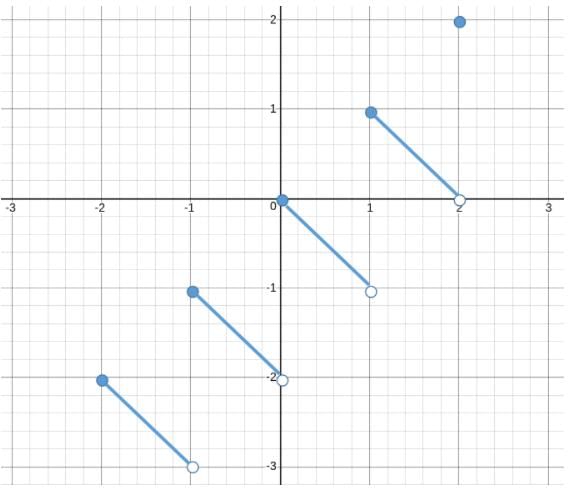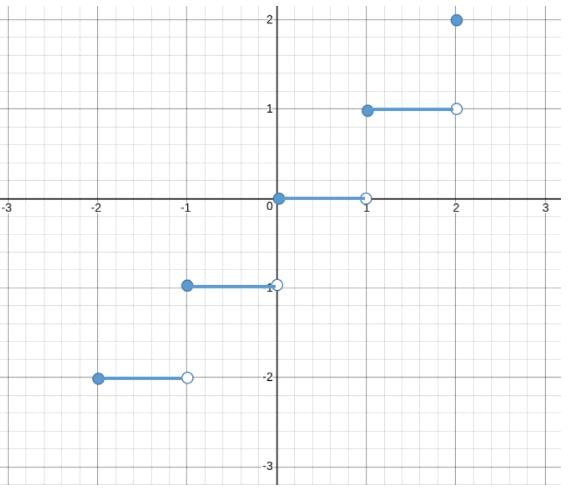CAT Exam > CAT Questions > The following graph depicts function f(x) in ...
Start Learning for Free
The following graph depicts function f(x) in the domain of x ∈ [−2,2]

To describe the value of f(x) for integers, a blue filled circle is given. For example, f(0) = 0, f(1) = 1.
Which of the following represents f(x)?
Here [x] : Greatest integer function. It is defined as the greatest integer less than or equal to x
{x} : Fractional part function. It is defined as x - [x]
- a)[x] - {x}
- b)[x] + {x}
- c)x-{x}
- d)x+{x}
Correct answer is option 'A'. Can you explain this answer?
Most Upvoted Answer
The following graph depicts function f(x) in the domain of x ∈ [&...
Graph of [x] is

Graph of {x} is

When we subtract the second graph from the first, we can see that the graph we get is the same as mentioned in the question.
Hence, [x] - {x} , Option A.
Alternate method:
To find the answer, we can also insert values in the functions mentioned.
For the graph given in the question, the value of the function at x=1.5 is 0.5. We can find this by looking at the x and y coordinates of a point in the graph.
Checking the options, we get
A: [x]=1 ; {x}=0.5
1-0.5=0.5: Equal to the one in the given graph.
1-0.5=0.5: Equal to the one in the given graph.
B: 1+0.5=1.5: hence eliminated
C:1.5-0.5=1: hence eliminated.
D:1.5+0.5=2: hence eliminated
Hence, [x] - {x} , Option A.

|
Explore Courses for CAT exam
|

|
Similar CAT Doubts
The following graph depicts function f(x) in the domain of x ∈ [−2,2]To describe the value of f(x) for integers, a blue filled circle is given. For example, f(0) = 0, f(1) = 1.Which of the following represents f(x)?Here [x] : Greatest integer function. It is defined as the greatest integer less than or equal to x {x} : Fractional part function. It is defined as x - [x]a)[x] - {x}b)[x] + {x}c)x-{x}d)x+{x}Correct answer is option 'A'. Can you explain this answer?
Question Description
The following graph depicts function f(x) in the domain of x ∈ [−2,2]To describe the value of f(x) for integers, a blue filled circle is given. For example, f(0) = 0, f(1) = 1.Which of the following represents f(x)?Here [x] : Greatest integer function. It is defined as the greatest integer less than or equal to x {x} : Fractional part function. It is defined as x - [x]a)[x] - {x}b)[x] + {x}c)x-{x}d)x+{x}Correct answer is option 'A'. Can you explain this answer? for CAT 2025 is part of CAT preparation. The Question and answers have been prepared according to the CAT exam syllabus. Information about The following graph depicts function f(x) in the domain of x ∈ [−2,2]To describe the value of f(x) for integers, a blue filled circle is given. For example, f(0) = 0, f(1) = 1.Which of the following represents f(x)?Here [x] : Greatest integer function. It is defined as the greatest integer less than or equal to x {x} : Fractional part function. It is defined as x - [x]a)[x] - {x}b)[x] + {x}c)x-{x}d)x+{x}Correct answer is option 'A'. Can you explain this answer? covers all topics & solutions for CAT 2025 Exam. Find important definitions, questions, meanings, examples, exercises and tests below for The following graph depicts function f(x) in the domain of x ∈ [−2,2]To describe the value of f(x) for integers, a blue filled circle is given. For example, f(0) = 0, f(1) = 1.Which of the following represents f(x)?Here [x] : Greatest integer function. It is defined as the greatest integer less than or equal to x {x} : Fractional part function. It is defined as x - [x]a)[x] - {x}b)[x] + {x}c)x-{x}d)x+{x}Correct answer is option 'A'. Can you explain this answer?.
The following graph depicts function f(x) in the domain of x ∈ [−2,2]To describe the value of f(x) for integers, a blue filled circle is given. For example, f(0) = 0, f(1) = 1.Which of the following represents f(x)?Here [x] : Greatest integer function. It is defined as the greatest integer less than or equal to x {x} : Fractional part function. It is defined as x - [x]a)[x] - {x}b)[x] + {x}c)x-{x}d)x+{x}Correct answer is option 'A'. Can you explain this answer? for CAT 2025 is part of CAT preparation. The Question and answers have been prepared according to the CAT exam syllabus. Information about The following graph depicts function f(x) in the domain of x ∈ [−2,2]To describe the value of f(x) for integers, a blue filled circle is given. For example, f(0) = 0, f(1) = 1.Which of the following represents f(x)?Here [x] : Greatest integer function. It is defined as the greatest integer less than or equal to x {x} : Fractional part function. It is defined as x - [x]a)[x] - {x}b)[x] + {x}c)x-{x}d)x+{x}Correct answer is option 'A'. Can you explain this answer? covers all topics & solutions for CAT 2025 Exam. Find important definitions, questions, meanings, examples, exercises and tests below for The following graph depicts function f(x) in the domain of x ∈ [−2,2]To describe the value of f(x) for integers, a blue filled circle is given. For example, f(0) = 0, f(1) = 1.Which of the following represents f(x)?Here [x] : Greatest integer function. It is defined as the greatest integer less than or equal to x {x} : Fractional part function. It is defined as x - [x]a)[x] - {x}b)[x] + {x}c)x-{x}d)x+{x}Correct answer is option 'A'. Can you explain this answer?.
Solutions for The following graph depicts function f(x) in the domain of x ∈ [−2,2]To describe the value of f(x) for integers, a blue filled circle is given. For example, f(0) = 0, f(1) = 1.Which of the following represents f(x)?Here [x] : Greatest integer function. It is defined as the greatest integer less than or equal to x {x} : Fractional part function. It is defined as x - [x]a)[x] - {x}b)[x] + {x}c)x-{x}d)x+{x}Correct answer is option 'A'. Can you explain this answer? in English & in Hindi are available as part of our courses for CAT.
Download more important topics, notes, lectures and mock test series for CAT Exam by signing up for free.
Here you can find the meaning of The following graph depicts function f(x) in the domain of x ∈ [−2,2]To describe the value of f(x) for integers, a blue filled circle is given. For example, f(0) = 0, f(1) = 1.Which of the following represents f(x)?Here [x] : Greatest integer function. It is defined as the greatest integer less than or equal to x {x} : Fractional part function. It is defined as x - [x]a)[x] - {x}b)[x] + {x}c)x-{x}d)x+{x}Correct answer is option 'A'. Can you explain this answer? defined & explained in the simplest way possible. Besides giving the explanation of
The following graph depicts function f(x) in the domain of x ∈ [−2,2]To describe the value of f(x) for integers, a blue filled circle is given. For example, f(0) = 0, f(1) = 1.Which of the following represents f(x)?Here [x] : Greatest integer function. It is defined as the greatest integer less than or equal to x {x} : Fractional part function. It is defined as x - [x]a)[x] - {x}b)[x] + {x}c)x-{x}d)x+{x}Correct answer is option 'A'. Can you explain this answer?, a detailed solution for The following graph depicts function f(x) in the domain of x ∈ [−2,2]To describe the value of f(x) for integers, a blue filled circle is given. For example, f(0) = 0, f(1) = 1.Which of the following represents f(x)?Here [x] : Greatest integer function. It is defined as the greatest integer less than or equal to x {x} : Fractional part function. It is defined as x - [x]a)[x] - {x}b)[x] + {x}c)x-{x}d)x+{x}Correct answer is option 'A'. Can you explain this answer? has been provided alongside types of The following graph depicts function f(x) in the domain of x ∈ [−2,2]To describe the value of f(x) for integers, a blue filled circle is given. For example, f(0) = 0, f(1) = 1.Which of the following represents f(x)?Here [x] : Greatest integer function. It is defined as the greatest integer less than or equal to x {x} : Fractional part function. It is defined as x - [x]a)[x] - {x}b)[x] + {x}c)x-{x}d)x+{x}Correct answer is option 'A'. Can you explain this answer? theory, EduRev gives you an
ample number of questions to practice The following graph depicts function f(x) in the domain of x ∈ [−2,2]To describe the value of f(x) for integers, a blue filled circle is given. For example, f(0) = 0, f(1) = 1.Which of the following represents f(x)?Here [x] : Greatest integer function. It is defined as the greatest integer less than or equal to x {x} : Fractional part function. It is defined as x - [x]a)[x] - {x}b)[x] + {x}c)x-{x}d)x+{x}Correct answer is option 'A'. Can you explain this answer? tests, examples and also practice CAT tests.

|
Explore Courses for CAT exam
|

|
Signup for Free!
Signup to see your scores go up within 7 days! Learn & Practice with 1000+ FREE Notes, Videos & Tests.
























